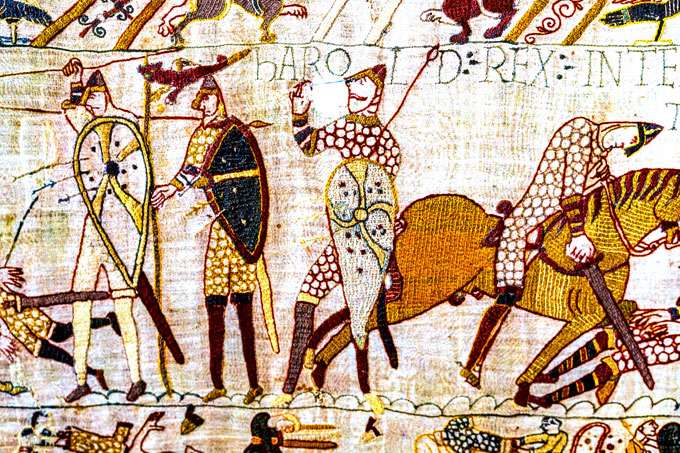The Bayeux Tapestry looks set to return to the UK for the first time in 900 years, and Professor Leonie Hicks explains its history, significance and Canterbury connections.
The Bayeux Tapestry is in the news again and it looks like its loan to the British Museum is likely to happen following President Macron’s statement yesterday. The museum in Bayeux will close in the autumn for renovations, so this is a unique opportunity.
It is one of the most significant works of art from the eleventh century. Most likely commissioned by William the Conqueror’s half-brother Odo, Bishop of Bayeux, it tells the story of the events leading up to the battle of Hastings in 1066. We see Harold’s ill-fated trip to Normandy, his swearing allegiance to William on holy relics, preparations for the invasion and the battle itself. It is, at times, a moving reminder of the brutality of war.
The Tapestry (actually an embroidery in wool on linen measuring 70mx0.5m) has a Kent connection. Following the conquest, Odo was given the Earldom of Kent. Current historical scholarship suggests the artefact was designed and made at St Augustine’s Abbey in Canterbury by a team of embroiderers. It is not solely about the Norman victory, but also commemorates the memory of people associated with the monastic community linking with the abbey’s necrology (list of dead associated with the house). The Tapestry’s design may well have been influenced by the artwork in manuscripts created at and held in Canterbury.
The proposed loan of the tapestry is an excellent way to start the European Year of the Normans in 2027 and examine the shared heritage either side of the Channel. This is an initiative led by the Conseil régional de Normandie and will involve significant events in Canterbury as well as elsewhere in the UK. It is an excellent opportunity for countries across Europe to work together to share and explain our histories.
Professor Leonie Hicks is Professor of Medieval Studies.
Canterbury Christ Church University occupies part of St Augustine’s Abbey, within the Canterbury UNESCO World Heritage Site, where the Bayeux Tapestry may have been created.
 Expert comment
Expert comment Jeanette Earl
Jeanette Earl 4421
4421


